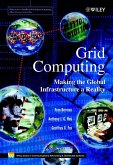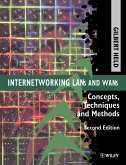Daniel Minoli
A Networking Approach to Grid Computing
Daniel Minoli
A Networking Approach to Grid Computing
- Gebundenes Buch
- Merkliste
- Auf die Merkliste
- Bewerten Bewerten
- Teilen
- Produkt teilen
- Produkterinnerung
- Produkterinnerung
The book explores practical advantages of Grid Computing and what is needed by an organization to migrate to this new computing paradigm. Intended for practitioners and decision-makers who want to explore the overall business opportunities afforded by this new technology, as well as for software programmers, this self-contained reference makes both the concepts and applications of grid computing clear and understandable to even non-technical managers. It explains the underlying networking mechanism and answers such questions critical to the business enterprise as "What is grid computing?";…mehr
Andere Kunden interessierten sich auch für
![Network Congestion Control Network Congestion Control]() Michael WelzlNetwork Congestion Control141,99 €
Michael WelzlNetwork Congestion Control141,99 €![Grid Computing Grid Computing]() Anthony J. G. HeyGrid Computing182,99 €
Anthony J. G. HeyGrid Computing182,99 €![Network Performance Analysis Network Performance Analysis]() Thomas BonaldNetwork Performance Analysis179,99 €
Thomas BonaldNetwork Performance Analysis179,99 €![Network Coding Network Coding]() Network Coding179,99 €
Network Coding179,99 €![Total Area Networking Total Area Networking]() John AtkinsTotal Area Networking182,99 €
John AtkinsTotal Area Networking182,99 €![Internetworking LANs and WANs Internetworking LANs and WANs]() Gilbert HeldInternetworking LANs and WANs182,99 €
Gilbert HeldInternetworking LANs and WANs182,99 €![Data Communication and Networks Data Communication and Networks]() James IrvineData Communication and Networks85,99 €
James IrvineData Communication and Networks85,99 €-
-
-
The book explores practical advantages of Grid Computing and what is needed by an organization to migrate to this new computing paradigm. Intended for practitioners and decision-makers who want to explore the overall business opportunities afforded by this new technology, as well as for software programmers, this self-contained reference makes both the concepts and applications of grid computing clear and understandable to even non-technical managers. It explains the underlying networking mechanism and answers such questions critical to the business enterprise as "What is grid computing?"; "How widespread is its present/potential penetration?"; "Is it ready for prime time?"; "Are there firm standards?"; "Is it secure?"; "How do we bill this new product?"; and "How can we deploy it (at a macro level)?"
Produktdetails
- Produktdetails
- Verlag: Wiley & Sons
- Artikelnr. des Verlages: 14668756000
- 1. Auflage
- Seitenzahl: 400
- Erscheinungstermin: 29. Oktober 2004
- Englisch
- Abmessung: 246mm x 159mm x 24mm
- Gewicht: 675g
- ISBN-13: 9780471687566
- ISBN-10: 0471687561
- Artikelnr.: 13174264
- Verlag: Wiley & Sons
- Artikelnr. des Verlages: 14668756000
- 1. Auflage
- Seitenzahl: 400
- Erscheinungstermin: 29. Oktober 2004
- Englisch
- Abmessung: 246mm x 159mm x 24mm
- Gewicht: 675g
- ISBN-13: 9780471687566
- ISBN-10: 0471687561
- Artikelnr.: 13174264
DANIEL MINOLI has many years of IT, telecom, and networking experience for end users and carriers including work at AIG, ARPA think tanks, Bell Telephone Laboratories, ITT, Prudential Securities, Bell Communications Research (Bellcore/Telcordia), AT&T, Gartner/DataPro, and high-tech incubator Leading Edge Networks Inc. He is the author of several books on Information Technology, telecommunications, and data communications, and has taught at New York University, Rutgers University, Stevens Institute of Technology, Carnegie Mellon University, and Monmouth University.
About the Author. Preface.Acknowldegments. 1. Introduction. 1.1 What Is
Grid Computing And What Are The Key Issues? 1.2 Potential Applications and
Financial Benefits of Grid Computing. 1.3 Grid Types, Topologies,
Components, Layers - A Preliminary View. 1.4 Comparison With Other
Approaches. 1.5 A First View at Grid Computing Standards. 1.6 A Pragmatic
Course of Investigation. 2. Grid Benefits and Status of Technology. 2.1
Motivations For Considering Computational Grids. 2.2 Brief History of
Computing, Communications, and Grid Computing. Communication. Computation.
Grid Technology. 2.3 Is Grid Computing Ready for Prime Time? 2.4 Early
Suppliers and Vendors. 2.5 Possible Economic Value. 2.6 Challenges. 3.
Components of Grid Computing Systems/Architectures. 3.1 Overview. 3.2 Basic
Constituent Elements - A Functional View. Portal/User Interface
Function/Functional Block. The Grid Security Infrastructure: User Security
Function/Functional Block. Node Security Function/Functional Block. Broker
Function/Functional Block And Directory. Scheduler Function/Functional
Block. Data Management Function/Functional Block. Job Management And
Resource Management Function/Functional Block. User/Application Submission
Function/Functional Block. Resources. Protocols. 3.3 Basic Constituent
Elements - A Physical View. Networks. Computation. Storage. Scientific
Instruments. Software and licenses. 3.4 Basic Constituent Elements -
Service View. 4. Standards Supporting Grid Computing: OGSI. 4.1
Introduction. 4.2 Motivations for Standardization. 4.3 Architectural
Constructs. 4.4 What is OGSA/OGSI? A Practical View. 4.5 OGSA/OGSI Service
Elements and Layered Model. 4.6 What is OGSA/OGSI? A More Detailed View.
4.7 A Possible Application Of OGSA/OGSI To Next-Generation Open-Source
Outsourcing. 5. Standards Supporting Grid Computing: OGSA. 5.1
Introduction. 5.2 Functionality Requirements. 5.3 OGSA Service Taxonomy.
5.4 Service Relationships. 5.5 OGSA Services. 5.6 Security Considerations.
5.7 Examples of OGSA Mechanisms in Support of VO Structures. 6. Grid System
Deployment Issues and Approaches. 6.1 Generic Implementations: Globus
Toolkit. 6.2 Grid Computing Environments. 6.3 Basic Grid Deployment and
Management Issues. 6.4 Grid Security Details - Deployment Peace of Mind. 7.
Grid System Economics. 7.1 Introduction. 7.2 Grid Economic Services
Architecture. 8. Communication Systems for Local Grids. 8.1 Introduction
and Positioning. 8.2 SAN-related Technology. 8.3 LAN-related Technology. 9.
Communication systems for national grids. 9.1 MLF. 9.2 MPLS Technology. 10.
Communication Systems for Global Grids. 10.1 The Basics of Layer 2 and
layer 3 VPNs. 10.2 The Layer 3 Approach. 10.3 Layer 2 MPLS VPNs-A Different
Philosophy. 10.4 Which Works Better Where?. 10.5 A Grid Computing
Application. References. Glossary. Index.
Grid Computing And What Are The Key Issues? 1.2 Potential Applications and
Financial Benefits of Grid Computing. 1.3 Grid Types, Topologies,
Components, Layers - A Preliminary View. 1.4 Comparison With Other
Approaches. 1.5 A First View at Grid Computing Standards. 1.6 A Pragmatic
Course of Investigation. 2. Grid Benefits and Status of Technology. 2.1
Motivations For Considering Computational Grids. 2.2 Brief History of
Computing, Communications, and Grid Computing. Communication. Computation.
Grid Technology. 2.3 Is Grid Computing Ready for Prime Time? 2.4 Early
Suppliers and Vendors. 2.5 Possible Economic Value. 2.6 Challenges. 3.
Components of Grid Computing Systems/Architectures. 3.1 Overview. 3.2 Basic
Constituent Elements - A Functional View. Portal/User Interface
Function/Functional Block. The Grid Security Infrastructure: User Security
Function/Functional Block. Node Security Function/Functional Block. Broker
Function/Functional Block And Directory. Scheduler Function/Functional
Block. Data Management Function/Functional Block. Job Management And
Resource Management Function/Functional Block. User/Application Submission
Function/Functional Block. Resources. Protocols. 3.3 Basic Constituent
Elements - A Physical View. Networks. Computation. Storage. Scientific
Instruments. Software and licenses. 3.4 Basic Constituent Elements -
Service View. 4. Standards Supporting Grid Computing: OGSI. 4.1
Introduction. 4.2 Motivations for Standardization. 4.3 Architectural
Constructs. 4.4 What is OGSA/OGSI? A Practical View. 4.5 OGSA/OGSI Service
Elements and Layered Model. 4.6 What is OGSA/OGSI? A More Detailed View.
4.7 A Possible Application Of OGSA/OGSI To Next-Generation Open-Source
Outsourcing. 5. Standards Supporting Grid Computing: OGSA. 5.1
Introduction. 5.2 Functionality Requirements. 5.3 OGSA Service Taxonomy.
5.4 Service Relationships. 5.5 OGSA Services. 5.6 Security Considerations.
5.7 Examples of OGSA Mechanisms in Support of VO Structures. 6. Grid System
Deployment Issues and Approaches. 6.1 Generic Implementations: Globus
Toolkit. 6.2 Grid Computing Environments. 6.3 Basic Grid Deployment and
Management Issues. 6.4 Grid Security Details - Deployment Peace of Mind. 7.
Grid System Economics. 7.1 Introduction. 7.2 Grid Economic Services
Architecture. 8. Communication Systems for Local Grids. 8.1 Introduction
and Positioning. 8.2 SAN-related Technology. 8.3 LAN-related Technology. 9.
Communication systems for national grids. 9.1 MLF. 9.2 MPLS Technology. 10.
Communication Systems for Global Grids. 10.1 The Basics of Layer 2 and
layer 3 VPNs. 10.2 The Layer 3 Approach. 10.3 Layer 2 MPLS VPNs-A Different
Philosophy. 10.4 Which Works Better Where?. 10.5 A Grid Computing
Application. References. Glossary. Index.
About the Author. Preface.Acknowldegments. 1. Introduction. 1.1 What Is
Grid Computing And What Are The Key Issues? 1.2 Potential Applications and
Financial Benefits of Grid Computing. 1.3 Grid Types, Topologies,
Components, Layers - A Preliminary View. 1.4 Comparison With Other
Approaches. 1.5 A First View at Grid Computing Standards. 1.6 A Pragmatic
Course of Investigation. 2. Grid Benefits and Status of Technology. 2.1
Motivations For Considering Computational Grids. 2.2 Brief History of
Computing, Communications, and Grid Computing. Communication. Computation.
Grid Technology. 2.3 Is Grid Computing Ready for Prime Time? 2.4 Early
Suppliers and Vendors. 2.5 Possible Economic Value. 2.6 Challenges. 3.
Components of Grid Computing Systems/Architectures. 3.1 Overview. 3.2 Basic
Constituent Elements - A Functional View. Portal/User Interface
Function/Functional Block. The Grid Security Infrastructure: User Security
Function/Functional Block. Node Security Function/Functional Block. Broker
Function/Functional Block And Directory. Scheduler Function/Functional
Block. Data Management Function/Functional Block. Job Management And
Resource Management Function/Functional Block. User/Application Submission
Function/Functional Block. Resources. Protocols. 3.3 Basic Constituent
Elements - A Physical View. Networks. Computation. Storage. Scientific
Instruments. Software and licenses. 3.4 Basic Constituent Elements -
Service View. 4. Standards Supporting Grid Computing: OGSI. 4.1
Introduction. 4.2 Motivations for Standardization. 4.3 Architectural
Constructs. 4.4 What is OGSA/OGSI? A Practical View. 4.5 OGSA/OGSI Service
Elements and Layered Model. 4.6 What is OGSA/OGSI? A More Detailed View.
4.7 A Possible Application Of OGSA/OGSI To Next-Generation Open-Source
Outsourcing. 5. Standards Supporting Grid Computing: OGSA. 5.1
Introduction. 5.2 Functionality Requirements. 5.3 OGSA Service Taxonomy.
5.4 Service Relationships. 5.5 OGSA Services. 5.6 Security Considerations.
5.7 Examples of OGSA Mechanisms in Support of VO Structures. 6. Grid System
Deployment Issues and Approaches. 6.1 Generic Implementations: Globus
Toolkit. 6.2 Grid Computing Environments. 6.3 Basic Grid Deployment and
Management Issues. 6.4 Grid Security Details - Deployment Peace of Mind. 7.
Grid System Economics. 7.1 Introduction. 7.2 Grid Economic Services
Architecture. 8. Communication Systems for Local Grids. 8.1 Introduction
and Positioning. 8.2 SAN-related Technology. 8.3 LAN-related Technology. 9.
Communication systems for national grids. 9.1 MLF. 9.2 MPLS Technology. 10.
Communication Systems for Global Grids. 10.1 The Basics of Layer 2 and
layer 3 VPNs. 10.2 The Layer 3 Approach. 10.3 Layer 2 MPLS VPNs-A Different
Philosophy. 10.4 Which Works Better Where?. 10.5 A Grid Computing
Application. References. Glossary. Index.
Grid Computing And What Are The Key Issues? 1.2 Potential Applications and
Financial Benefits of Grid Computing. 1.3 Grid Types, Topologies,
Components, Layers - A Preliminary View. 1.4 Comparison With Other
Approaches. 1.5 A First View at Grid Computing Standards. 1.6 A Pragmatic
Course of Investigation. 2. Grid Benefits and Status of Technology. 2.1
Motivations For Considering Computational Grids. 2.2 Brief History of
Computing, Communications, and Grid Computing. Communication. Computation.
Grid Technology. 2.3 Is Grid Computing Ready for Prime Time? 2.4 Early
Suppliers and Vendors. 2.5 Possible Economic Value. 2.6 Challenges. 3.
Components of Grid Computing Systems/Architectures. 3.1 Overview. 3.2 Basic
Constituent Elements - A Functional View. Portal/User Interface
Function/Functional Block. The Grid Security Infrastructure: User Security
Function/Functional Block. Node Security Function/Functional Block. Broker
Function/Functional Block And Directory. Scheduler Function/Functional
Block. Data Management Function/Functional Block. Job Management And
Resource Management Function/Functional Block. User/Application Submission
Function/Functional Block. Resources. Protocols. 3.3 Basic Constituent
Elements - A Physical View. Networks. Computation. Storage. Scientific
Instruments. Software and licenses. 3.4 Basic Constituent Elements -
Service View. 4. Standards Supporting Grid Computing: OGSI. 4.1
Introduction. 4.2 Motivations for Standardization. 4.3 Architectural
Constructs. 4.4 What is OGSA/OGSI? A Practical View. 4.5 OGSA/OGSI Service
Elements and Layered Model. 4.6 What is OGSA/OGSI? A More Detailed View.
4.7 A Possible Application Of OGSA/OGSI To Next-Generation Open-Source
Outsourcing. 5. Standards Supporting Grid Computing: OGSA. 5.1
Introduction. 5.2 Functionality Requirements. 5.3 OGSA Service Taxonomy.
5.4 Service Relationships. 5.5 OGSA Services. 5.6 Security Considerations.
5.7 Examples of OGSA Mechanisms in Support of VO Structures. 6. Grid System
Deployment Issues and Approaches. 6.1 Generic Implementations: Globus
Toolkit. 6.2 Grid Computing Environments. 6.3 Basic Grid Deployment and
Management Issues. 6.4 Grid Security Details - Deployment Peace of Mind. 7.
Grid System Economics. 7.1 Introduction. 7.2 Grid Economic Services
Architecture. 8. Communication Systems for Local Grids. 8.1 Introduction
and Positioning. 8.2 SAN-related Technology. 8.3 LAN-related Technology. 9.
Communication systems for national grids. 9.1 MLF. 9.2 MPLS Technology. 10.
Communication Systems for Global Grids. 10.1 The Basics of Layer 2 and
layer 3 VPNs. 10.2 The Layer 3 Approach. 10.3 Layer 2 MPLS VPNs-A Different
Philosophy. 10.4 Which Works Better Where?. 10.5 A Grid Computing
Application. References. Glossary. Index.








